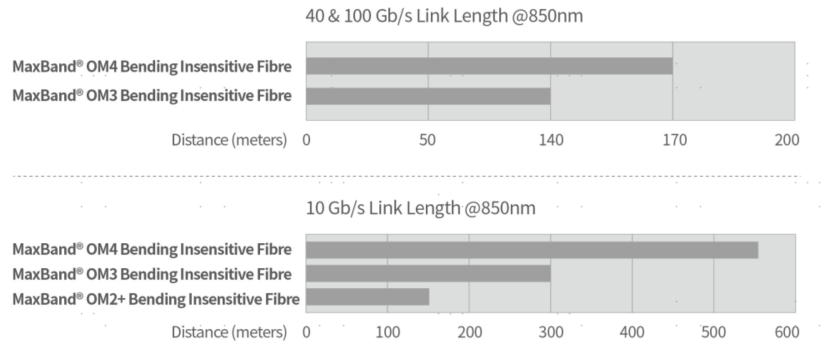
YOFC MaxBand® OM2+ Bending Insensitive Multimode Fibre complies with or exceeds ISO/IEC 11801-1 OM2 specification, IEC 60793-2-10 A1-OM2 specification, and TIA-492AAAF A1-OM2 specification.
YOFC MaxBand® OM3/OM4 Bending Insensitive Multimode Fibres comply with or exceed ISO/IEC 11801-1 OM3/OM4 specifications, IEC 60793-2-10 A1-OM3/A1-OM4 specfications, and TIA-492AAAF A1-OM3/A1-OM4 specifications.
| Features | Benefits and Applications |
|---|---|
|
|
|
|
|
|

|
Characteristics |
Conditions |
Specified values |
Units |
|---|---|---|---|
|
Geometry Characteristics |
|||
|
Core Diameter |
-- |
50±2.5 |
[μm] |
|
Core Non-Circularity |
-- |
≤5.0 |
[%] |
|
Cladding Diameter |
-- |
125.0±1.0 |
[μm] |
|
Cladding Non-Circularity |
-- |
≤0.6 |
[%] |
|
Coating Diameter |
-- |
245±7 |
[μm] |
|
Coating/Cladding Concentricity Error |
-- |
≤10.0 |
[μm] |
|
Coating Non-Circularity |
-- |
≤6.0 |
[%] |
|
Core/Cladding Concentricity Error |
-- |
≤1.0 |
[μm] |
|
Delivery Length |
-- |
up to 8.8 |
[km/reel] |
|
Optical Characteristics |
|||
|
Attenuation |
850nm |
≤2.4 |
[dB/km] |
|
1300nm |
≤0.6 |
[dB/km] |
|
|
-- |
-- |
MaxBand® OM2+/OM3/OM4 Bend Insensitive |
|
|
Overfilled Modal Bandwidth |
850nm |
≥700/≥1500/≥3500 |
[MHz·km] |
|
1300nm |
≥500/≥500/≥500 |
[MHz·km] |
|
|
Effective Modal Bandwidth |
850nm |
≥950/≥2000/≥4700 |
[MHz·km] |
|
Application support distance on |
-- |
-- |
-- |
|
40GBASE-SR4 / 100GBASE-SR101 |
850nm |
-/140/170 |
[m] |
|
10GBASE-SR |
850nm |
150/300/550 |
[m] |
|
1000BASE-SR |
850nm |
750/1000/1100 |
[m] |
|
DMD Specification |
Compliant with and more stringent than the requirements of IEC60793-2-10 |
-- |
|
|
Numerical Aperture |
-- |
0.200±0.015 |
-- |
|
Group Refractive Index |
850nm |
1.482 |
-- |
|
1300nm |
1.477 |
-- |
|
|
Zero Dispersion Wavelength(λ0) |
-- |
1295-1340 |
[nm] |
|
Zero Dispersion Slope(S0) |
1295nm≤λ0≤1310nm |
≤0.105 |
[ps/(nm2·km)] |
|
1310nm≤λ0≤1340nm |
≤0.000375(1590-λ0) |
[ps/(nm2·km)] |
|
|
Macrobending Loss2 |
-- |
-- |
-- |
|
2 Turns @ 15 mm Radius |
850nm |
≤0.1 |
[dB] |
|
1300nm |
≤0.3 |
[dB] |
|
|
2 Turns @ 7.5 mm Radius |
850nm |
≤0.2 |
[dB] |
|
1300nm |
≤0.5 |
[dB] |
|
|
Backscatter Characteristics |
1300nm | ||
|
Step(Mean of Bidirectional Measurement) |
-- |
≤0.10 |
[dB] |
|
Irregularities Over Fibre Length and Point Discontinuity |
-- |
≤0.10 |
[dB] |
|
Attenuation Uniformity |
-- |
≤0.08 |
[dB/km] |
|
Environmental Characteristics |
850nm & 1300nm | ||
|
Temperature Cycling |
-60℃ to 85℃ |
≤0.10 |
[dB/km] |
|
Temperature-Humidity Cycling |
-10℃ to 85℃,4% to 98% RH |
≤0.10 |
[dB/km] |
|
Water Immersion |
23℃, 30 days |
≤0.10 |
[dB/km] |
|
Dry Heat |
85℃,30 days |
≤0.10 |
[dB/km] |
|
Damp Heat |
85℃, 85% RH,30 days |
≤0.10 |
[dB/km] |
|
Mechanical Specification |
|||
|
Proof Test |
-- |
≥9.0 |
[N] |
|
-- |
≥1.0 |
[%] |
|
|
-- |
≥100 |
[kpsi] |
|
|
Coating Strip Force |
typical average force |
1.5 |
[N] |
|
peak force |
≥1.3, ≤8.9 |
[N] |
|
|
Dynamic Stress Corrosion Susceptibility Parameter(nd, typical) |
-- |
20 |
-- |
Remarks: 1. Support distances considering maximum cable attenuation of 3.0 dB/km at 850 nm,
maximum total splice/connector loss of 1.0 dB and VCSELs maximum RMS spectral width ≤ 0.45 nm.
2. The launch condition for the macrobending loss measurement fulfils that described in IEC 61280-4-1.